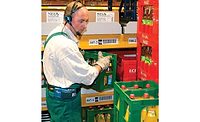Voice-picking technology’s ease of use aids warehouse integration
Wearable technology to expand to other warehouse workflows

Honeywell Voice technology focuses on such areas as processor speed, operating system, pick up and go speech recognition technology, and built-in sensors for better data capturing, James Hendrickson says. (Image courtesy of Honeywell)
The tile-matching video game Tetris challenged adolescents in the 1980s and beyond in a race against the clock to position various geometric shapes in order to eliminate rows of tiles before the game screen fills up. Although beverage warehouses don’t have products falling from the sky, personnel still are tasked with positioning and retrieving a vast inventory for an industry that continues to see a growing number of SKUs.
“SKU proliferation has made warehouse operations much more complex,” says Mark Wheeler, warehouse vertical practice lead for Zebra Technologies, Lincolnshire, Ill. “This trend is having a massive impact on warehouses working with the beverage industry. Think about all of the traditional soda labels and then add in diet, flavored and classic varieties. Now, add to that all of the various juices and varieties of water including flavored and sparkling as well as niche beverages like energy drinks and what used to be a simple set of SKUs a decade ago is now an entire category managed by an account manager.”
James Hendrickson, director of product management and offering for Charlotte, N.C.-based Honeywell, explains that flexibility has become a vital component of warehouse operations as companies strive for accuracy while managing the growing number of SKUs.
“For example, increasing inventory of a specific type of product from five SKUs to 20 SKUs naturally can have an impact on how warehouse operations manage this growth,” he says. “Having a flexible solution, like voice-picking technology, can help to make the transition to larger SKU volume more manageable. Additionally, SKU proliferation requires that warehouse operations maintain or improve their accuracy.
“Today, the supply chain is expected to deliver a seamless and flawless experience at all points in the value chain,” Hendrickson continues. “Anything less than perfect — from a poor customer experience to delays in shipping or processing to a cumbersome returns process — reflects negatively on the business and can prove costly. The addition of additional SKUs to a warehouse only compounds this as more and more products become available in one [distribution center] (DC) location.”
Beyond SKU proliferation, Zebra Technologies’ Wheeler adds that eCommerce trends are changing the landscape of warehouse operations. “Indirectly, eCommerce means that grocery shelves will never run out of an item,” he says. “Direct-store-delivery (DSD) traditionally relied on shelf demand but now it relies on an online opportunity to click and select an in-stock item. This puts added stress on warehouse operations and forces companies to improve warehouse processes to keep up with the demand.”
Considering these factors, Wheeler highlights how voice-picking technology is helping beverage warehouses improve fulfillment. “SKU proliferation is driving complexity in fulfillment operations,” he says. “This can lead to a very good return on investment (ROI) for voice-directed picking as well as other wearable technology solutions such as wrist-worn mobile computers and wearable scanners that can provide real-time information, improve worker productivity and reduce errors.”
Designed for today’s needs
As warehouse operators navigate the demands of today’s distribution market, research shows that wearable technology is a solution that companies are employing.
“According to Zebra’s recently published ‘Warehouse Vision Study,’ 62 percent of respondents are planning to invest in wearable technologies over the next two to three years,” Wheeler says.
One of the selling points for utilizing voice-picking technology is the ease of use for operators. “Rapid employee onboarding is often cited as one of the biggest benefits of voice-directed solutions,” Wheeler says.
Honeywell’s Hendrickson further elaborates on the onboarding benefits of voice-picking solutions.
“Voice technology provides a simple and straightforward training template to rapidly get workers up and running in the DC — ensuring that the mobile worker is equipped to succeed from day one,” he says. “For example, Honeywell Voice offers ‘pick up and go’ technology that eliminates training and enables the mobile worker to simply pick up our Honeywell A700x device and begin their work.
“Not only does this efficiency help mobile workers in any DC environment, but it also helps DC operations managers that are responsible for hiring temporary or seasonal workers,” Hendrickson continues. “Additionally, all Honeywell Voice devices and headsets utilize TouchConnect for seamless pairing [of] a Honeywell mobile computing device and Bluetooth wireless headset — reducing shift start-up processes from minutes to seconds.”
Although voice-picking technology is not new to beverage warehouses, Hendrickson notes that the platform continually is improving its capabilities.
“While voice technology may be viewed as mature technology used by many companies worldwide, there are continual improvements made in this segment — from investments in technology that leverage deep neural networks to hardware that can perform in varying yet extreme environments, and software that is designed to support operations today and future growth,” he says.
Getting your money’s worth
Like any capital investment, warehouse operators want to be sure that the timeframe for a ROI helps in their business’ growth. However, predicting a ROI is not a one-size-fits-all scenario, experts warn.
“The return-on-investment (ROI) depends on many factors,” Zebra Technologies’ Wheeler says. “Complexity comes from higher order volumes, shorter order turnaround times and high SKU counts. Under these circumstances, voice-picking solutions can provide a ROI in less than 12 months. What’s most critical is to match the edge technology (voice, arm-mounted wearable, wearable display, wearable scanning, wearable printing or a combination of these) to the needs of the task at hand.”
For instance, wearable scanning can help ensure high accuracy or capture extended product data, Wheeler explains. On the other hand, by showing additional task information or product images, wearable display has the ability to extend voice, he adds. Finally, wearable technology can include wearable printing, which can speed up the shipping of products through the process of printing and applying the shipping label at the point of pick, Wheeler says.
Honeywell’s Hendrickson notes that businesses aren’t going to invest in any technology that doesn’t have a defined ROI. Instead, businesses are more concerned with total-cost-of-ownership (TCO).
“Businesses must partner with a trusted vendor [that] can help them assess their technology requirements as well as fully outline the initial and long-term costs for such investments,” he says.
Hendrickson notes that the next steps for voice-picking technology will be its expansion into other tasks in the warehouse.
“What is next ties back into what was mentioned earlier, [which is] expanding into other workflows — replenishment, restocking, pick and pack — and continuing to integrate seamlessly with other emerging technology trends like vision picking, augmented reality and robotics,” he says. “Those latter trends when tied to the mobile worked create a true cobot experience within the DC.”
Zebra Technologies Wheeler also thinks that voice-technology is poised for great things. “Voice will match up well as a technology that complements wearable display solutions for the task worker,” he says. “Wearable display technology is poised to become a key solution for case-pick in beverage. With the right software, it can be as intuitive to use as voice.” BI
Looking for a reprint of this article?
From high-res PDFs to custom plaques, order your copy today!







